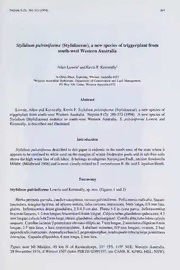
Stylidium pulviniforme (Stylidiaceae), a new species of triggerplant from south-west Western Australia PDF
Preview Stylidium pulviniforme (Stylidiaceae), a new species of triggerplant from south-west Western Australia
Nuytsia9(3): 369-373(1994) 369 Stylidiumpulviniforme (Stylidiaceae), a newspecies oftriggerplant from south-westWesternAustralia AllenLowrie'andKevinF. Kenneally^ '6GlennPlace,Duncraig,WesternAustralia6023 WesternAustralianHerbarium, DepartmentofConservationandLandManagement, POBox 104,Como,WesternAustralia6152 Abstract Lowrie, Allen and Kenneally, Kevin F. Stylidiumpulviniforme (Stylidiaceae), a new species of triggerplant from south-westWestern Australia. Nuytsia9 (3); 369-373 (1994). A new species of Stylidium (Stylidiaceae) endemic to south-west Western Australia, S. pulviniforme Lowrie and Kenneally, isdescribedandillustrated. Introduction Stylidiumpulviniforme describedin thispaperisendemic tothesouth-westofthe state where it appears tobeconfinedto whitesandon themarginsofwinterfreshwaterpools andinsalt-free soils abovethehighwaterlineofsaltlakes. ItbelongstosubgenusNitrangiumEndl.,sectionSonderella Mildbr. (Mildbraed 1908)andismost closelyrelatedtoS. corymbosumR.Br.andS. lepidumBenth. Taxonomy StylidiumpulviniformeLowrieandKenneally, sp. nov. (Figures 1 and2) Herbaperennisparvula,caudicecaespitoso,ramosopulviniformi. Foliaomniaradicalia, lineari- lanceolata, marginehyalino, adapicem serrata, infracarinata, mucronata, 3mm longa,0.9 mm lata, glabra. Inflorescentiadenseglandulosa,2.5-4.5cm alta. Flores 3-5 incymaparva. Inflorescentiae mm mm bracteaelineares,1-2 longae;bracteolae0.6 longae. Calycistubusglanduloso-pubescens,4.5 mm mm longus;calycislobi2 longi,obtusi,glandulosi,albomarginati. Corollaalba;tuboloboscalycis mm mm aequans. Corollaelaciniae2posterioresobovato-ellipticae,7 longae,2anterioresellipticae6 mm mm longae, 2.7 latae, e basi roseomaculatae. Labellum minutum, 0.9 longum, ovatum, 2 basi appendiculisinstructum. Appendicesfaucis2,pegmatimorphae,intubopauloinfralaciniasposteriores mm mm instructae. Capsulaellipsoidea, 6 longa, 2 lata. Typus: near Mt Madden, 40 km N of Ravensthorpe, 33° 15'S, 119° 50'E, Western Australia, 28November 1974,E.Wittwer 1507(holo: PERTH02991357;iso: CANB, K,KPBG,MEL,NSW). 370 NuytsiaVol.9,No,3(1994) FCig-uhryepa1n,Stthyiluimdisuhmopwuilnvginiinfodrummee.nAtu-mfloofwgelrainndgupllaarnth;aiBrs-;lDeaf-ocfobraoslallar(loesfett)tsehsohwoiwnigngdeatdaaixlioafltvhireowat(r(riigghhtt))a;nEd-laetnelraalrgveidewse(cltefito)n; ofthecorollatubeshowingledge-likeappendageinthroat;F-labellum;G-lateralviewofcolumn(left),withthestigmagrown out(right);H-adaxialviewofcolumnandanthers(left),withthestigmagrownout(right);I-abaxialviewofcolumnshowing antherstage(left)andstigmastage(right). Scalebar=1 mm. DrawnfromLowrie 121(PERTH). AllenLowrieandKevinF.Kenneally,Stylidiumpulviniforme 371 Smallcaespitoseperennial, branched so asto form adense flat-topped hard cushionup toc. 30 cmdiameter. Leavessilvery grey, all basal, linear-lanceolate, glabrous, 3 mm long, 0.6 mm wide, with a white hyaline margin, serrate near apex; lower surface carinate, the ridge hyaline like the margins. Inflorescencescymose,3-5flowered,2.5-4.5cmhigh,denselyglandular;bractslinear, 1-2 mm mm mm long; bracteoles 0.6 long. Hypanthium narrow-cylindrical 4.5 long, glandular- mm pubescent. Sepals2 long, freetobase,obtuse,glandular-pubescent,hyaline-margined. Corolla mm mm white,verticallypaired;tubeequalinlengthtosepals;twoanteriorlobeselliptic,6 long,2.7 widewithredmarksatthebaseofeachlobe;twoposteriorlobesobovate-elliptic,7mmlong,4mm wide. Labellumminute,ovate,0.9mmlong,withtwobasalappendages,positionedonasmall keel- like ridge attached along the length ofthe corolla tube. Throat with 2 appendages in the form of mm mm minuteledges deepinthroatbelow posteriorlobes. Capsuleellipsoid, 6 long and 2 wide. Seeds pale, densely papillate. Figure2. Stylidiumpulviniforme. PhotographoffloweringmaterialcultivatedattheWesternAustralian Herbarium,grownfromplantscollectedatthetypelocalitybyE.Wittwer,November1974. 372 NuytsiaVol.9,No.3(1994) Other specimens examined. WESTERN AUSTRALIA: Lake Johnston, 17 October 1984, H. Demarz 10354 (KPBG); wherethePhillipsRivercrossestheHyden-Ravensthorperoad, c. 4km NofthejunctionofFitzgeraldandBeattyRoads, 17October\99Q,AUenLowrie121 (PERTH,MEL) and 7December 1990, Allen Lowrie 220 (PERTH); 2 miles east of Duladgin Rocks (31°10'S 119°4rE) north ofYellowdine, 2 September 1966,A./f. Main s.n. (PERTH). Distribution. CoolgardieDistrictoftheSouth-westernInterzoneandtheRoeDistrictofSouth-west BotanicalProvince(Beard 1980),extendingfromYellowdineinthenorthtoMtMaddeninthesouth and eastwards to Lake Johnston. Ecology. Thisspeciesoccursinwhitesandonthemarginsofwinterfreshwaterpoolsandinsalt-free soilsabovethehighwaterline ofsaltlakes. Theassociatedvegetation is ashrublandofMelaleuca thyoides Turcz. and Darwiniadiosmoides (DC.) Benth. Flowering period. September-November. Conservationstatus. CALMConservationCodeforWesternAustralianFlora:PriorityOne- Poorly Known Taxa- known from one or afew (generally <5) populations which are underthreat. Chromosome number. n=14. Etymology. Thespecificepithetalludestothehabitofthenewspeciesinformingcoloniesofcushion- like plants. Discussion The new species is distinctive, although clearly relatedto S. corymbosumR. Br. and S. lepidum Benth. These three species are similar in having small, cymose inflorescences (not racemes), and ledge-likethroatappendagesbornewelldowninthethroat(Erickson 1958). Stylidiumpulviniforme differsfromS. corymbosumandS. lepiduminhaving averyshortglandularscape,veryshortleaves withwhitehyalinemargins(serrateneartheapex)andacarinateridgeontheirabaxialsurface;white corolla lobes, which are markedred at base, and a short ovary. Thecolumn ofS. pulviniforme is similartothatof5.lepiduminthattheybothworkfrombelow,thepollenorstigmatouchingthelower side ofan insect’s abdomen. Key to Stylidiumpulviniforme and related species 1. Leaf margins entire S.corymbosum 1. Leafmargins serrate 2. Scape glabrous; labellum with apical point S. lepidum 2. Scape densely glandular hairy; labellum without apical point S. pulviniforme The seed coats of Stylidium species appear to provide a useful taxonomic character for identification,anditisourintentiontoexaminethisfeatureinforthcomingpublications.S.pulviniforme has a seed coat with a densely papillate surface. (Figure 3) AllenLowrieandKevinF.Kenneally,Stylidiumpulviniforme 373 Figure3. SEMphotographsofaseedofS.pulviniformeshowingthedenselypapillatesurface. FromLowrie220(PERTH). Acknowledgements We wish to thankMrs Pauline Farrell, Kings Park and Botanic Garden, Perth forchecking the collecting details of the type material. Dr John Kuo, Electron Microscopy Centre, University of Western Australia, kindly provided the SEM photographs and Dr S. James, Botany Department, University ofWestern Australia, the chromosome count. References Beard,J.S.(1980). AnewphytogeographicmapofWesternAustralia. WesternAustralianHerbariumRes.NotesNo.3:37-58. Erickson,Rica(1958)."Triggerplants". (PatersonBrokenshaPtyLtd:Perth.) Milbraed, J. (1908) Stylidiaceae. In: E. Engler, (ed.) Das Planzenreich IV no.278 (35), 98 pp. (Verlag H.R. Engelmann, Weinheim:Germany.)
